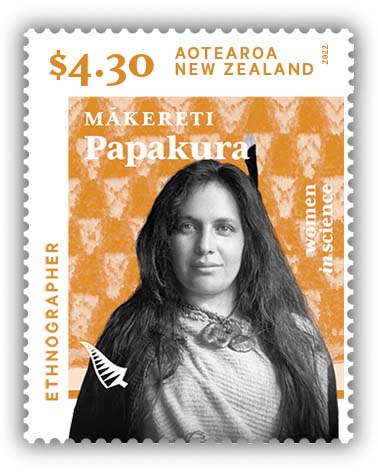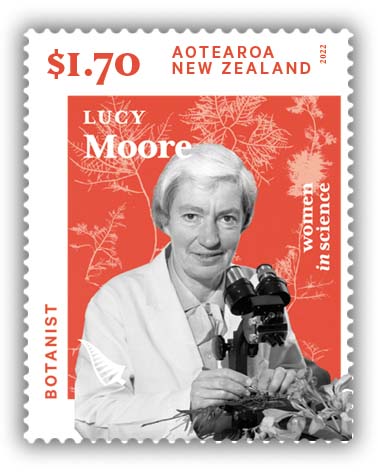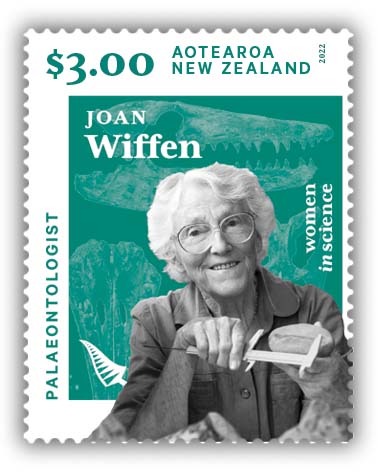Women in Science
Posted by Lynette Townsend on 2nd Nov 2022
Mākereti Papakura, Lucy Moore, Joan Wiffen and Beatrice Hill Tinsley are the four scientists who feature on the new ‘Women in Science’ stamp release. They were four remarkable scientists who achieved in the fields of ethnography, botany, palaeontology and cosmology in the 20th century. Their contributions opened our eyes to our past, the natural world, our cultural traditions and legacies, and the universe. These four women exemplified a spirit of intellectual curiosity that widened horizons for those who followed.
The following expands on some of each woman’s achievements and their contribution to science and our understanding of the world.

Mākereti Papakura (1873-1930)
Raised according to the traditions of her hapū in the small settlement of Parekārangi, south of Rotorua, then educated in English, Mākereti Papakura (1873-1930) was adept at bridging worlds. An accomplished host and guide at Whakarewarewa, she moved to England in 1912 to marry Oxfordshire landowner Richard Staples-Browne and, after her divorce in 1924, enrolled at the University of Oxford for a BSc in anthropology. Papakura’s lived experience at a time of colonisation, encounter and exchange, alongside her deep appreciation of the mātauranga of her people, meant that her thesis, The Old-Time Māori, provided a near-unique scholarly analysis of customary practices within Te Arawa from the perspective of a woman. Wāhine Māori were critical knowledge holders and practitioners of mātauranga Māori pre-colonisation, with Tainui woman Kahupeka (c. 1400s) credited with the discovery of a wide range of plants and their medicinal properties, including kawakawa.

Lucy Moore (1906-1987)
A lifelong tramper, mountaineer and beachcomber, Lucy Moore (1906-1987) was fortunate in that her interest in the natural world was supported by her family and encouraged at Epsom Girls Grammar School, where she met her friend and collaborator Lucy Cranwell. Known as one of ‘the Two Lucies’ by classmates at Auckland University College, Moore initially struggled to find employment in science, working as a demonstrator and tutor, but started in the Botany Division of the Department of Scientific and Industrial Research (DSIR) in 1938, focusing on weeds, algae and fungi. Moore’s expertise in botany saw her edit several ground-breaking works of taxonomy, and she continued this work after her retirement from the DSIR in 1971, producing The Oxford Book of New Zealand Plants in 1978. Moore’s meticulously detailed reference works are still regularly picked up by New Zealand scientists, gardeners and nature-lovers.

Beatrice Hill Tinsley (1941-1981)
In the second half of the twentieth century, further fields of scientific discovery became accessible to women. After graduating from Canterbury University College with an MSc in physics, Beatrice Hill Tinsley (1941-1981) completed a PhD on the evolution of galaxies at the University of Texas at Austin. As a theoretical astrophysicist, her main tool was not a telescope, but a computer. Through her research, which covered star formation, stellar evolution and galactic evolution, she concluded that rather than having constant luminosity, galaxies became dimmer with age. In her short but remarkable career in the United States, Hill Tinsley proved that the universe was infinite and would expand forever, and that galaxies evolved and interacted with each other.

Joan Wiffen (1922-2009)
Other women came to science without university training, and without paid employment. A geology night class inspired Joan Wiffen (1922-2009) to start fossicking for minerals and fossils. Her greatest discoveries were found close to her Hawke’s Bay home, in the Mangahouanga Stream north of Napier, which she explored with her husband Pont and their two children. There, she found the fossils of ancient marine reptiles such as the mosasaur and plesiosaur and, in 1975, Aotearoa’s first dinosaur bone – a tail bone from a theropod, a carnivorous dinosaur that walked on two legs. Wiffen continued fossil hunting, and writing scientific papers to describe her finds, until well into her 80s. Her finds included carnivorous and herbivorous dinosaurs, including theropods, a sauropod, an armoured ankylosaur and a flying reptile called a pterosaur.
Challenges
Born between 1873 and 1941, the women featured on these stamps achieved in the face of institutional and societal structures that often made things difficult for women. Mākereti Papakura drew on her whānau and consulted hapū elders to collate years of letters, notebooks and sketches that provided insights into the lives of Māori women, who were often ignored or undervalued by men writing about Māori society. New Zealand’s main science employer, the DSIR, did not employ any women as scientists until the late 1930s, when Lucy Moore was finally able to secure permanent work more than 10 years after her graduation. The career of the brilliant Beatrice Hill Tinsley came second to her husband’s career - when his job took them to the United States in the 1960s, she shouldered the bulk of the housework and childcare responsibilities, and nepotism rules prevented her getting a job at the same university as him.
Geology and astronomy remain two of the most male dominated scientific disciplines. Joan Wiffen was self-taught, and even in the 1980s, when she made most of her discoveries, had trouble being taken seriously by the country’s almost exclusively male geology workforce. Throughout the twentieth century women seeking a career in geology were hampered by moral arguments about whether or not women should be ‘allowed’ to do fieldwork – a geologist’s job typically involved spending weeks or even months working outdoors, sleeping in huts or tents – and by legislation. Until the 1990s, a legal ban on women working underground meant women were excluded from geology jobs in the mining industry. Nonetheless, there were women who persevered and shone in this discipline.
The number of women graduating and working in science has increased in recent years, encouraged by government and industry initiatives, so that women now make up more than 50% of science degree graduates, while men still dominate in senior positions. Increasingly, it is recognised that women’s success in scientific careers requires more than just ensuring more women study science; here in Aotearoa New Zealand and internationally, there are calls to change the culture of science to be more collaborative and inclusive to ensure that those women who do study science can flourish. In New Zealand, early career researchers are leading the way, redefining opportunities for the 21st century scientific workforce.
This media post is based on an article by Kate Hannah and Rebecca Priestley. Read the full article in ‘New Zealand Stories in Stamps 2022’ published by NZ Post Collectables.
